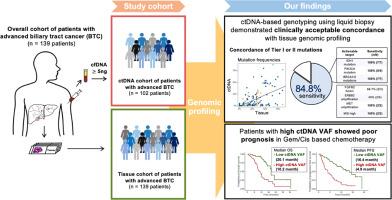Concordance of ctDNA and tissue genomic profiling in advanced biliary tract cancer
IF 26.8
1区 医学
Q1 GASTROENTEROLOGY & HEPATOLOGY
引用次数: 0
Abstract
Background & Aims
Recent advances in molecular profiling have enabled the identification of potential therapeutic targets for biliary tract cancer (BTC). However, in patients with BTC, molecular profiling is hindered by challenges in obtaining adequate tissue samples. Circulating tumor DNA (ctDNA) may offer an alternative to tissue-based analysis. Herein, we aimed to assess the concordance between ctDNA and tissue genomic profiling in a large cohort of Asian patients with advanced BTC, and to evaluate the feasibility of liquid biopsy in BTC treatment.
Methods
This study included patients with systemic treatment-naive advanced BTC, treated at CHA Bundang Medical Center between January 2019 and December 2022. We enrolled patients with available baseline tissue-based next-generation sequencing, and sufficient plasma samples for ctDNA analysis (AlphaLiquid®100 from IMBdx).
Results
Among 102 enrolled patients, 49.0% had intrahepatic cholangiocarcinoma, 26.5% extrahepatic cholangiocarcinoma, and 24.5% gallbladder cancer. The concordance between intra-patient ctDNA and tumor tissue mutations revealed a sensitivity of 84.8%, and positive predictive value of 79.4%. ctDNA revealed targetable alterations in 34.3% of patients – including FGFR2 fusions, IDH1 mutations, microsatellite instability-high, ERBB2 amplifications, PIK3CA mutations, BRCA1/2 mutations, and MET amplifications. Notably, a novel FGFR2-TNS1 fusion was identified in ctDNA, which was not targeted in the tissue NGS panel. A high maximum somatic variant allele frequency in ctDNA was associated with poor prognosis after gemcitabine/cisplatin-based chemotherapy, in terms of both overall survival (p = 6.9 × 10−6) and progression-free survival (p = 3.8 × 10−7).
Conclusions
Among patients with advanced BTC, ctDNA-based genotyping showed acceptable concordance with tissue genomic profiling. Liquid biopsy using ctDNA could be a valuable complement to tissue-based genomic analysis in BTC.
Impact and implications
Our study is the first large-scale investigation of the clinical utility of liquid biopsy, focusing on circulating tumor DNA (ctDNA), as an alternative to conventional tumor tissue analysis, among Asian patients with advanced biliary tract cancer. The results demonstrated acceptable concordance between analysis of ctDNA vs. tissue for identifying therapeutic targets and potentially actionable genetic alterations. This indicates that ctDNA analysis can provide critical insights regarding advanced biliary tract cancer treatment, particularly in cases where it is challenging to obtain or analyze tumor tissue.


晚期胆道癌中ctDNA和组织基因组图谱分析的一致性
背景与ampamp; 目的分子图谱分析的最新进展有助于确定胆道癌(BTC)的潜在治疗靶点。然而,由于难以获得足够的组织样本,BTC 患者的分子图谱分析受到了阻碍。循环肿瘤 DNA(ctDNA)可作为组织分析的替代方法。本研究纳入了2019年1月至2022年12月期间在CHA盆唐医疗中心接受治疗的全身治疗无效的晚期BTC患者。结果102名入组患者中,49.0%患有肝内胆管癌,26.5%患有肝外胆管癌,24.5%患有胆囊癌。34.3%的患者的ctDNA发现了靶向性改变,包括FGFR2融合、IDH1突变、微卫星不稳定性(MSI)-高、ERBB2扩增、PIK3CA突变、BRCA1/2突变和MET扩增。值得注意的是,在ctDNA中发现了一种新型的FGFR2-TNS1融合体,而组织NGS面板并未针对该融合体。结论在晚期 BTC 患者中,基于 ctDNA 的基因分型与组织基因组图谱分析显示出可接受的一致性。影响和意义我们的研究是首次在亚洲晚期 BTC 患者中大规模调查以 ctDNA 为重点的液体活检替代传统肿瘤组织分析的临床实用性。研究结果表明,ctDNA 分析与组织分析在确定治疗靶点和潜在可操作基因改变方面具有可接受的一致性。这表明,ctDNA 分析能为晚期 BTC 治疗提供重要见解,尤其是在难以获得或分析肿瘤组织的情况下。
本文章由计算机程序翻译,如有差异,请以英文原文为准。
求助全文
约1分钟内获得全文
求助全文
来源期刊

Journal of Hepatology
医学-胃肠肝病学
CiteScore
46.10
自引率
4.30%
发文量
2325
审稿时长
30 days
期刊介绍:
The Journal of Hepatology is the official publication of the European Association for the Study of the Liver (EASL). It is dedicated to presenting clinical and basic research in the field of hepatology through original papers, reviews, case reports, and letters to the Editor. The Journal is published in English and may consider supplements that pass an editorial review.
 求助内容:
求助内容: 应助结果提醒方式:
应助结果提醒方式:


